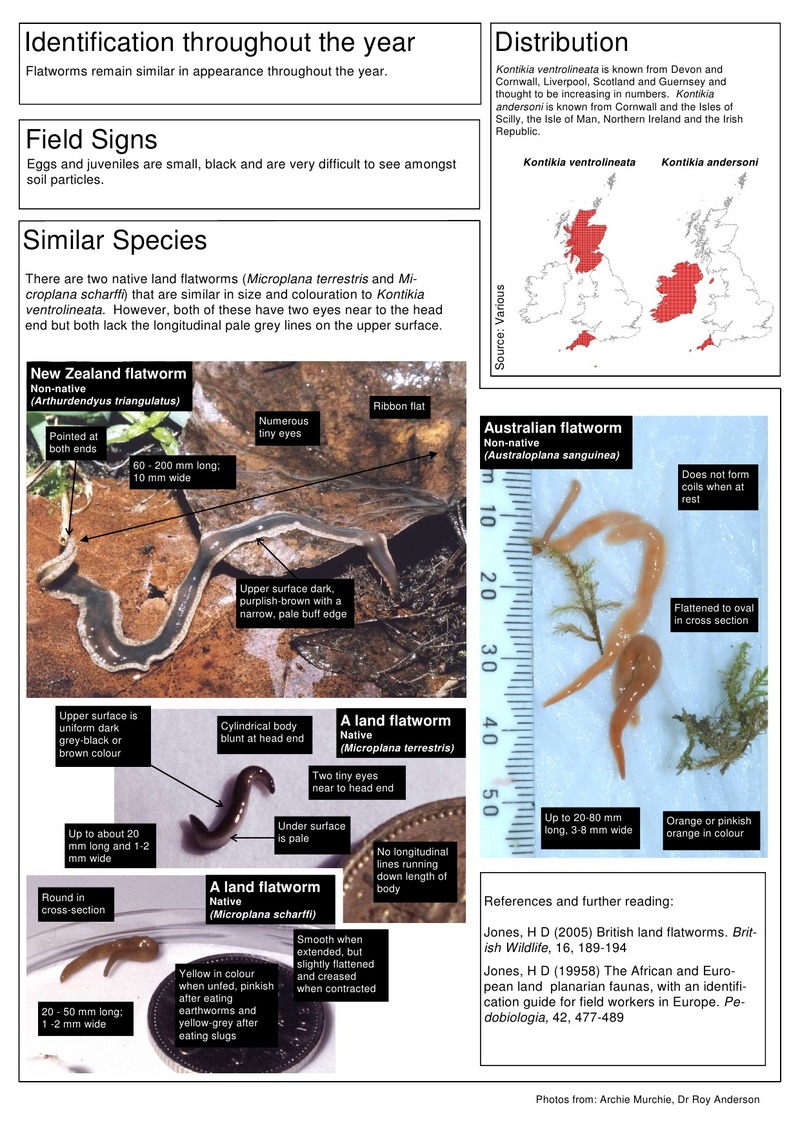|
| 질의: description | 결과: 9422번째/10150 | |
Kontikia flatworms (Page 2)
| 제목: | Kontikia flatworms (Page 2)
| |

| 해상도: 1240x1755
파일크기: 569253 Bytes
등록시간: 2012:07:25 13:32:56
|
www.nonnativespecies.org
Produced by Max Wade, Vicky Ames and Kelly McKee of RPS
Kontikia flatworms
Species Description
Scientific name: Kontikia ventrolineata and Kontikia andersoni
Native to: Australia and/or New Zealand
Habitat: Gardens, nurseries, garden centres, parks, pasture and on wasteland
Small terrestrial flatworms, oval or cylindrical in cross-section. Kontikia andersoni is pale brown with three rows of darker brown spots along its body length with the middle row narrower than either of the side rows. It has relatively large eyes along the edge of the upper surface. Kontikia ventrolineata has very dark, almost black base colour with two narrow, pale grey lines on the upper surface running down the length of the body close to the mid-line, and four dark lines on the under-surface. There are many eyes along the edge of its upper surface but these are difficult to see because of dark body colour.
Kontikia ventolineata is thought to have been introduced in 1840. No known introduction date is known for Kontikia andersoni. During the day they are found sheltering on the soil surface in damp places, such as under plastic or other sheeting, rocks, flat stones and plant containers. Their origin is unknown but likely to be Australia or New Zealand where they are found in urban and horticultural land, garden centres and similar commercial places. Kontikia ventrolineata feeds on any small invertebrates that it can catch, including snails and possibly slugs.
Kontikia ventrolineata is listed under Schedule 9 to the Wildlife and Countryside Act 1981 with respect to England and Wales. As such, it is an offence to release or allow the escape of this species into the wild.
For details of legislation go to www.nonnativespecies.org/legislation.
Identification throughout the year
Flatworms remain similar in appearance throughout the year.
Distribution
Kontikia ventrolineata is known from Devon and Cornwall, Liverpool, Scotland and Guernsey and thought to be increasing in numbers. Kontikia andersoni is known from Cornwall and the Isles of Scilly, the Isle of Man, Northern Ireland and the Irish Republic.
Field Signs
Eggs and juveniles are small, black and are very difficult to see amongst soil particles.
Similar Species
There are two native land flatworms (Microplana terrestris and Microplana scharffi) that are similar in size and colouration to Kontikia ventrolineata. However, both of these have two eyes near to the head end but both lack the longitudinal pale grey lines on the upper surface.
New Zealand flatworm
Non-native
(Arthurdendyus triangulatus)
Australian flatworm
Non-native
(Australoplana sanguinea)
A land flatworm
Native
(Microplana terrestris)
A land flatworm
Native
(Microplana scharffi) |
^o^
동물그림창고 똑똑전화 누리집
^o^
|
|